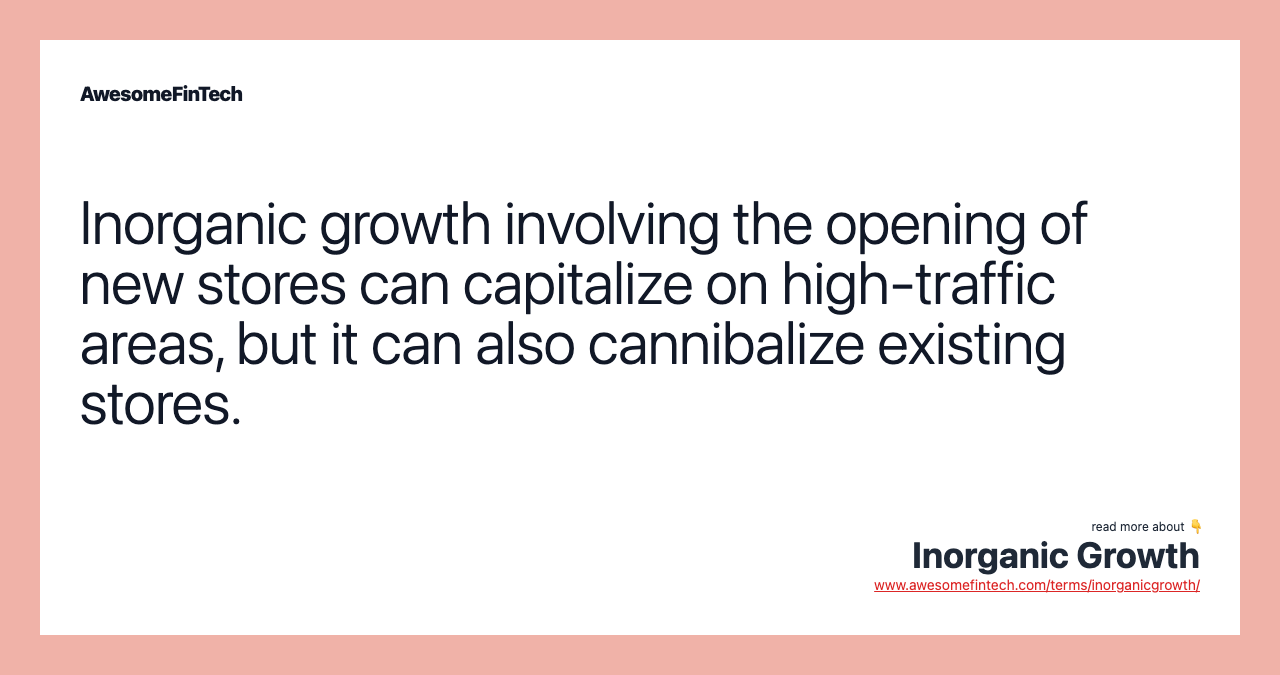Inorganic Growth
Inorganic growth arises from mergers or takeovers rather than an increase in the company's own business activity. A company may have positive sales growth due to acquisitions while same-store-sales growth may decline due to a decrease in foot traffic. Meanwhile, organic growth is internal growth the company sees from its operations, often measured by same-store or comparable sales. Inorganic growth is considered a faster way for a company to grow compared to organic growth. By opening new stores in profitable locations, businesses can take advantage of the higher growth rates associated with new stores.

What Is Inorganic Growth?
Inorganic growth arises from mergers or takeovers rather than an increase in the company's own business activity. Firms that choose to grow inorganically can gain access to new markets through successful mergers and acquisitions. Inorganic growth is considered a faster way for a company to grow compared to organic growth.





Understanding Inorganic Growth
One of the most important measures of performance for fundamental analysts is growth, particularly in sales. Sales growth can be the result of promotional efforts, new product lines and improved customer service, which are internal, or organic, measures.
Growth in organic sales is often described in terms of comparable sales or same-store-sales when referring to retail outlets. In other words, these sales occur naturally and not through the acquisition of another company or the opening of new stores. Some analysts consider organic sales to be a better indicator of company performance. A company may have positive sales growth due to acquisitions while same-store-sales growth may decline due to a decrease in foot traffic. Analysts research organic sales by analyzing inorganic sales growth.
Special Considerations
Firms can choose to grow inorganically in several ways including engaging in mergers and acquisitions and, in the case of retail or branch organizations, opening new stores or branches. Mergers are challenging from an integration perspective. Acquisitions can be accretive to earnings, but the implementation of the technology or knowledge acquired can take time. In other words, pulling the value out of mergers and acquisitions is more complex than taking credit for sales. Costs in the form of restructuring charges can greatly increase expenses. The purchase price of the acquisition can also be prohibitive for some firms.
By opening new stores in profitable locations, businesses can take advantage of the higher growth rates associated with new stores. However, when new stores are placed in locations that cannibalize sales and/or do not have enough traffic to support those stores, they can be a drag on sales.
Inorganic Growth vs. Organic Growth
Which is best, inorganic or organic growth? Inorganic growth, such as a boost from acquisitions, can provide a short-term boost. However, steady and slow organic growth can be viewed as superior, as it shows the company has the ability to make money regardless of the economic backdrop. Plus, there’s the downside of potentially using debt to fund inorganic growth. On the flipside, inorganic growth might not fully repair declining organic growth or internal issues.
Advantages and Disadvantages of Inorganic Growth
If a company merges with another in pursuit of inorganic growth, that company's market share and assets become larger. This offers immediate benefits such as the additional skills and expertise of new staff and a greater likelihood of obtaining capital when needed. As well, it allows a company to grow much faster and almost immediately increase its market share.
However, there are disadvantages in that additional management is required, the direction of the business may go in an unanticipated direction, there may be additional debt or a company could grow too quickly incurring substantial risk. The downsides to inorganic growth is the large upfront costs and management challenges with integrating acquisitions.
Related terms:
Acquisition
An acquisition is a corporate action in which one company purchases most or all of another company's shares to gain control of that company. read more
Acquisition Premium
An acquisition premium is is a figure that's the difference between the estimated real value of a company and the actual price paid to acquire it. read more
All-Cash, All-Stock Offer
An all-cash, all-stock offer is a proposal by one company to purchase all of another company's outstanding shares from its shareholders for cash. read more
Bear Hug: Business
In business, a bear hug is an offer made by one company to buy the shares of another for a much higher per-share price than what that company is worth. read more
Conglomerate Merger
A conglomerate merger is a merger between firms that are involved in totally unrelated business activities. read more
Corporate Cannibalism
Corporate cannibalism is the reduction in sales volume or market share of a product after a new product has been introduced by the same organization. read more
Empire Building
Empire building is the attempt to grow the scope of an individual or organization's power and influence. Learn the pros and cons of empire building. read more
Exchange Ratio
The exchange ratio is the number of new shares that will be given to existing shareholders of a company that has been acquired or has merged with another. read more
Horizontal Merger
A horizontal merger is a merger or business consolidation that occurs between firms that operate in the same industry, usually as larger companies attempt to create more efficient economies of scale. read more
Hostile Takeover
A hostile takeover is the acquisition of one company by another without approval from the target company's management. read more